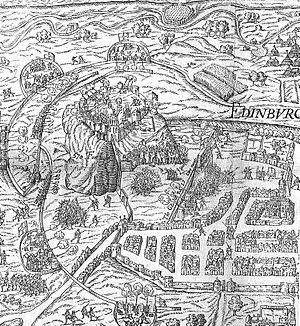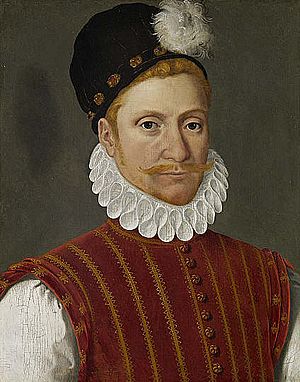William Kirkcaldy of Grange facts for kids
Sir William Kirkcaldy of Grange (born around 1520 – died 3 August 1573) was a brave Scottish soldier and important leader. He fought for big changes in Scotland's religion, known as the Scottish Reformation. Later in his life, he famously defended Edinburgh Castle for Mary, Queen of Scots, until he was captured and sadly executed.
Contents
Early Life and Family
William Kirkcaldy came from a family that owned land at Hallyards Castle in Fife. His father, James Kirkcaldy of Grange, was an important government official who managed Scotland's money from 1537 to 1543. William married Margaret Learmonth, whose brother was a leader in St Andrews.
Soldier and Secret Agent
William Kirkcaldy was involved in many important events in Scotland. He was present when King James V of Scotland died in 1542. Later, he was part of a group that killed Cardinal Beaton in May 1546. Because of this, he was captured and sent to Normandy in France as a prisoner, but he managed to escape in 1550.
After escaping, William worked as a secret agent for King Edward VI of England. He was known by the code name "Corax." He also served in the French Army, where he became known for his skill and bravery.
In 1556, William was forgiven for his part in Cardinal Beaton's death. He returned to Scotland in 1557 and became famous after winning a duel against Ralph Eure, whose brother was the governor of Berwick-upon-Tweed.
Fighting for the Reformation
William Kirkcaldy was a Protestant and became a key leader of the Lords of the Congregation. This group fought against Mary of Guise, who was ruling Scotland for her young daughter, Mary, Queen of Scots. Kirkcaldy fought French soldiers in Fife, and his home at Hallyards was destroyed. In January 1560, he even took down part of Tullibody Old Bridge to slow down French troops heading to Stirling Castle.
In 1562, Mary, Queen of Scots made him a knight at Holyrood Palace. William did not agree with Queen Mary's marriage to Henry Stuart, Lord Darnley. He sided with Mary's half-brother, Lord James Stewart, during a time of conflict. This meant he had to hide in England for a short while.
William was against Mary's marriage to Bothwell. He wrote to an English diplomat, saying Mary seemed willing to lose everything for Bothwell. However, he later joined other lords to rescue Mary after her marriage. After the fight at Battle of Carberry Hill, the Queen surrendered to Kirkcaldy. Bothwell escaped, and Kirkcaldy chased him by sea to Shetland. He was made Lord High Admiral of Scotland for a time. He was determined to catch Bothwell, but his ship, the Lion, ran aground.
After Mary escaped from Loch Leven Castle, Kirkcaldy's military skills helped defeat her army at the Battle of Langside. He hoped for a peaceful agreement with Mary. He became close to William Maitland of Lethington, whom he helped escape from Edinburgh in 1569. This made his former friends suspicious of him.
The "Lang Siege" of Edinburgh Castle

After Regent Moray was killed in January 1570, William Kirkcaldy of Grange decided to support Mary, Queen of Scots. He was the captain and leader of Edinburgh Castle and the town. He began to make the castle and town stronger to defend them for Mary. He even freed one of his supporters from prison in Edinburgh, which caused an argument with his old friend, John Knox.
In April 1571, Kirkcaldy arrested some important citizens. The King's supporters set up their base in Leith. This period became known as the "Wars between Leith and Edinburgh." Kirkcaldy built strong defenses around the castle and in the town, especially on the Royal Mile and near St Giles' Cathedral. In October 1571, the town council moved to Leith. Kirkcaldy's men blocked streets and burned houses on the edge of the city to protect Edinburgh. The "Lang Siege" (long siege) of Edinburgh Castle began in mid-October when the King's regent, Regent Mar, brought cannons from Dumbarton Castle and Stirling Castle.
Grange received supplies and money from France, England, and the Southern Netherlands. He even set up a mint inside the castle to make silver coins and borrowed money by using Mary, Queen of Scots' jewelry as a promise to pay it back. In January 1573, William's brother, James Kirkcaldy, arrived with weapons and money from France, but he was captured. Kirkcaldy refused to make peace with Regent Morton because the peace terms did not include his friends.
Finally, English soldiers and cannons arrived to help Regent Morton. On 28 May 1573, Edinburgh Castle surrendered. The English commander, Sir William Drury, took Grange to his home. After a week, Grange was handed over to Regent Morton and imprisoned. Many people tried hard to save Kirkcaldy, but they were unsuccessful. He was hanged on 3 August 1573.
A year later, one of Grange's letters was found. It mentioned the jewels Mary, Queen of Scots had left behind and that Drury had taken some as a promise for a loan. Grange's wife, Margaret Learmonth, was in hiding, but her location became known when she was asked to return the jewels.
After His Death
On 15 July 1581, King James VI of Scotland gave William Kirkcaldy's lands back to his family. The King praised Kirkcaldy's bravery and service, mentioning his duel in 1557, his support for the Scottish Reformation, and his actions at Carberry Hill and his chase of Bothwell. The King said Kirkcaldy was one of the most important people God used to stop the old religion.
William's heir was his nephew, also named William Kirkcaldy, who was the son of his brother James.


